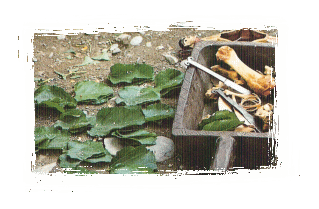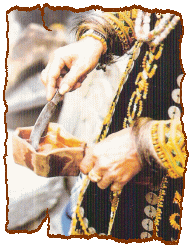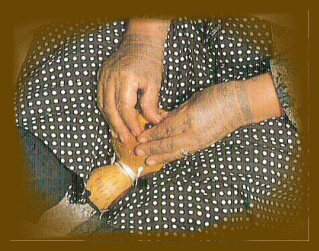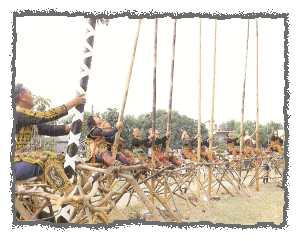|
| Utensils for the Ceremony |
Utensils for the Ceremony |
Fiesta Tray (tilju)
Wooden-carved rectangle-shaped tray especially reserved for the ceremony is used to place pig bones in sacrificial services. When the founder, named ljemedje, of the Gulou ceremony first came to the world of deity and learned from goddess Denger the ceremony of how to place pig bones on leaves (viaq) before sacrifice and then later become a lively pig. Therefore, on the tray there place different parts of bones of the pig to symbolize the whole pig as sacrifice. After high priest arranges the leaves, the pig bone has to be moistened by exhaling and then put on the leaves in order to show esteemed respects to the ancestors' deity. The leaves (with pig bone pieces) then will be put on top of people's head to pass on god's will and grant the spiritual power. |
| |
Fiesta Cup (tjavang)
Single cup is wooden-carved and used for filling water or liquor in the ceremony. Water cleanses, purifies, moist and returns to orthodox path; liquor has a meaning of appreciation and sharing.
|
| |
Fiesta Leaf (viaq)
The most commonly used in Gulou is mulberry leaves (ljisu). To begin the ceremony, the high priest arranges three leaves a pile (one leaf a pile is all right, if there is not enough leaf) and then cut both ends using fiesta knife to become a fiesta leaf as a hanging container. Fatty pork is put on the leaves to reinforce divine power.
|
| |
Fiesta Knife (siqunu)
Every high priest has personal knife in the ceremony after finishing the study with the master so as to be able to perform services of praying, warding off evil spirit, and curing the disease. The knife is used for cutting off fiesta leaves, paring pig bones, scraping iron pot, as meat cleaver, dipping water and liquor.
|

Image: Fiesta tray, Fiesta knife, Fiesta leaf and Pig bone.
|

Image: Fiesta cup and Fiesta knife.
|
|
|
Divine Bead (zaqu)
Divine beads are used by high priest to practice calabash (a bottle gourd) divination. There are three ways of saying the origin of bead: 1.Old high priest passes it on to the newly appointed high priest; 2.God grants the bead from heaven in the ceremony of assigning high priest; 3.Born with it.
|
| |
Divination Gourd (ljuyi)
Divine bead has to operate in the ceremony with the divination gourd which is self-made by high priest or passed on by the master priest. The high priest uses fiesta leaf to clip fatty pork and circle on the gourd when practice divination; then press divine bead on gourd's surface circling with thumbs and index fingers of both hands, chanting scriptures at the same time. If the bead sticks to the gourd, it means deity grants consent to the affairs prayed for.
|
| |
High Priest Box (kanupitj)
Dig out the internal part of a lumber block to become a square wooden box without lid. Separately, make a wooden lid or wired-net (with a thin rope to tighten). The box surface on the outside has various sculpture images such as colored drawing of human head, body, Hundred-pace Snake, deer, goat, wild boar and some with metal pieces nailed on. There used to have rattan-weaved priest box before. In order to save time and trouble these days, some use plain board as materials. The box is a container for ceremony utensils such as fiesta knife, leaf, pig bones, and divine bead.
|
| |
Sacrificial Implements for Five-Year Fiesta
The sacrificial implements (Siqudaquda) for Paiwan's Five-Year Fiesta are mainly ball-stabbing poles and divine balls. Measuring about fourteen meters, the pole (Djuljat) is made of sturdy dried bamboo as straight as an arrow and connected with a pointed tip. It can be categorized as the following: Rivariv is the longest one which represents the pole for the first ancestor spirit, Ljemedje. The second longest, Patjimi, is for the chieftain. The third, Gaus, with Hundred-pace Snake engraved on is for Tiagaraus who is the first ancestor to be a priest. Kaqurongang, the fourth longest, is stabbing pole for Valjilet's family that is in charge of tribal safety. The fifth (Ventjean) is for every other families, measuring the same length. Chieftain's pole has stabbing hooks (Saras) circled at the end. The number of hooks represents how many Tribes in the jurisdiction so as to show chief's reputation. Divine ball, Qapudung, is made of weaved tree bark (in ancient times, yellow rattan weaved.) In a formal sacrificial ceremony, sixteen divine balls are needed to play a game.
|
|
 |
|
|
Image: Divine bead and gourd |
Image: High Priest Box
|
Image: Ball-stabbing
|
| |
Source: Paiwan Tribe - Picture Book of Gulou Village Image: Paiwan Tribe - Picture Book of Gulou Village Edited by: Si-chih Tung, Chi-hua Cheng
|
|
Planned by volunteer teachers at Kuljaljau Elementary School, Laiyi Township Pingtung County, Year 2007; Made by Goblin’s Aspirational Team.
To view the contents on this website, a computer monitor with 1024x768 dpi and an Internet browser of Microsoft Internet Explorer 5.5 or above is recommended.
|






